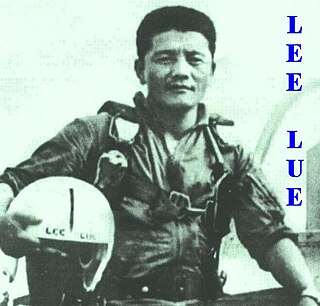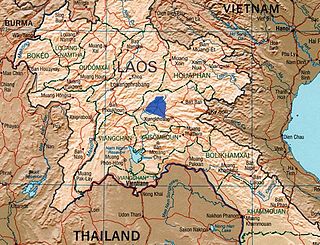
Captain Kong Le was a Laotian paratrooper in the Royal Lao Army. He led the premier unit of the Royal Lao Army, 2ème bataillon de parachutistes, which campaigned relentlessly during 1959 and 1960. The idealistic young American-trained Lao Theung officer became known worldwide when on 10 August 1960 he and his mutinous paratroopers overthrew the Royal Lao Government in a coup d'état. He declared he aimed at an end to government corruption; to the shock of American officials, he declared U.S. policies were responsible for the ongoing fraud.

Major Lee Lue was a Laotian Hmong fighter bomber pilot notable for flying 10-12 combat missions Kingdom of Laos. Lee Lue flew continuously, as many as 10 missions a day and averaging 112 combat missions a month to build a total 10-12 sorties. Lee Lue was the leader of the special group of Hmong pilots flying T-28Ds from Long Tieng against the Pathet Lao and North Vietnamese positions. The group was funded by the CIA and was part of the regular Royal Lao Air Force, but took orders directly from MR2 Commander Gen. Vang Pao. His T-28 was shot down by anti-aircraft fire over Muang Soui, crashing in a mountainous area near Ban Phou Pheung Noi on July 12, 1969. At the time of his death, he had 800 combat missions total the 14 months o
Operation Momentum was a guerrilla training program during the Laotian Civil War run by the Central Intelligence Agency to raise a guerrilla force of Hmong hill-tribesmen in northeastern Laos to fight the North Vietnamese Army (PAVN) and their Pathet Lao allies. It was planned by James William Lair and carried out by the Thai Police Aerial Reinforcement Unit. Begun on 17 January 1961, the three-day Auto Defense Choc course graduated a clandestine guerrilla army of 5,000 warriors by 1 May, and of 9,000 by August. It scored its first success the day after the first ADC company graduated, on 21 January 1961, when 20 ADC troopers ambushed and killed 15 Pathet Lao.
Operation Triangle was a military operation of the Laotian Civil War staged from 19—29 July 1964. Although planned by the General Staff of the Royal Lao Army, it was subject to American approval because the RLA depended on the Americans for finances, supplies, and munitions. Operation Triangle was an ambitious undertaking dependent on martial skills unfamiliar to the Lao. It not only called for coordination of infantry, artillery, and tactical air strikes among forces of three different nationalities; as a covert operation, it also had to have plausible deniability.
Operation Pigfat was a crucial guerrilla offensive of the Laotian Civil War; it lasted from 26 November 1968 to 7 January 1969. Launched by Hmong tribal soldiers backed by the Central Intelligence Agency, it was based on the usage of overwhelming air power to clear the path for the guerrillas. The guerrillas were faced with the largest concentration of Vietnamese communist troops stationed outside Vietnam, and hoped to spoil that imminent attack.
Operation Raindance was a military operation of the Laotian Civil War, staged from 17 March to 7 April 1969. It was launched by the U.S. Air Force (USAF) in support of Hmong guerrillas raised by the Central Intelligence Agency (CIA). As the guerrillas were being pressured by enemy troops pushing to within ten kilometers of their main bases, the aerial campaign was planned to cause a pullback by the pressing communists.
Operation Toan Thang was the first communist wet season offensive of the Laotian Civil War. Launched on 18 June 1969 and successful by the 27th, the assault by People's Army of Vietnam troops from the 312th Division and sappers of the 13th Dac Cong Battalion captured Muang Soui. Although the defenders outnumbered the assailants by three to one, the only hard surfaced airfield near the Plain of Jars would fall to the communists, depriving the defending Royal Lao Government of its only forward fighter-bomber base.
The Battle of Vientiane was the decisive action of the 1960 Laotian coups. Fought between 13 and 16 December 1960, the battle ended with General Phoumi Nosavan winning control of the Kingdom of Laos with the aid of the Royal Thai Government and the U.S. Central Intelligence Agency. Vientiane was left devastated by the fighting, with about 600 civilians dead, about the same number of homes destroyed, and 7,000 left homeless. The losing Forces Armées Neutralistes under Captain Kong Le retreated onto the strategic Plain of Jars, to begin an uneasy coexistence with the Pathet Lao and the invading People's Army of Vietnam.
Forces Armées Neutralistes was an armed political movement of the Laotian Civil War.
Kou Kiet was a major Laotian Civil War victory for the anti-communist troops of the Kingdom of Laos. Patterned after prior Operation Raindance, it depended upon extensive air strikes blasting communist units and clearing them from the path of the Royalist offensive. Powered by 150 daylight and 50 night sorties daily, with 50 to 80 day strikes directed by Raven Forward Air Controllers, Kou Kiet ran from 6 August to 30 September 1969. It was successful beyond expectations. After the Royal Lao Government troops achieved their objectives, General Vang Pao insisted on pushing forward while they had the initiative. As a result, the Royalists regained control of the entire Plain of Jars while also capturing a huge stock of munitions from the communist forces. Their triumph came at a huge cost. Even though the Royalists were successful, by battle's end their forces were exhausted and the pool of potential recruits were limited, while the Vietnamese could easily replace their personnel losses.
Operation Honorable Dragon was an offensive of the Second Indochina War. The Central Intelligence Agency, which equipped and trained the needed troops, aimed at disruption of the North Vietnamese communist supply line, the Ho Chi Minh Trail. Launched by six battalions of Royal Lao Army military irregulars on 31 August 1970, the operation achieved only limited success. Although the planned objective was captured on 25 September, the offensive was plagued by desertions and combat refusals, including a battalion that ran from "ghosts". After the conquest of Pakse Site 26, troops of the People's Army of Vietnam (PAVN) harassed the Lao occupiers through mid-December 1970.
Campaign 139 was a major military offensive of the People's Army of Vietnam, launched against its Royalist enemies during the Laotian Civil War. Larger than previous invading forces, Campaign 139 was also a combined arms expedition containing tanks, artillery, engineers, and Dac Cong sappers. As such, it was a decided escalation in the war. It was also an exceptional rainy season offensive by PAVN, which usually withdrew during the wet season.
Operation Counterpunch, waged 26 September 1970 to 7 January 1971, was a military offensive of the Laotian Civil War. Royalist General Vang Pao's guerrilla army regained the vital all-weather forward fighter base at Muang Soui on the Plain of Jars from the People's Army of Vietnam (PAVN). The preemptive Counterpunch was credited with delaying an imminent PAVN wet season offensive for a month. The guerrilla army survived, though still heavily outnumbered by the PAVN.

Campaign 74B was a major combined arms offensive by the People's Army of Vietnam (PAVN) during the Laotian Civil War. The Communist offensive, if successful, would knock the last remaining fighting troops of the Kingdom of Laos out of the war, ensuring the Vietnamese conquest of Laos. The PAVN 316th Division—reinforced by artillery, tanks, and sappers—attacked during a period of slackened tactical air support for General Vang Pao's guerrilla army; Operation Lam Son 719 was being waged at the same time. Having captured the highly strategic Plain of Jars during Operation 74B, the Communists attackers managed to penetrate deeply enough to fire upon the main guerrilla base at Long Tieng.

Campaign Z was a military offensive by the People's Army of Vietnam; it was a combined arms thrust designed to defeat the last Royal Lao Army troops defending the Kingdom of Laos. The Communist assault took Skyline Ridge overlooking the vital Royalist base of Long Tieng and forced the restationing of Royalist aviation assets and civilian refugees. However, Communist forces eventually receded back onto their lines of communication without capturing the base.
Operation Maharat was a military offensive of the Royal Lao Government aimed at Communist insurrectionists. At stake was the sole road junction in northern Laos well in the rear of Royalist troops fighting in Campaign Z. On 30 December 1971, the garrison of a Royal Lao Army artillery battery and two Forces Armées Neutralistes battalions was besieged by an attacking force of Pathet Lao and Patriotic Neutralists. On 21 January 1972, the Royalists were reinforced by 11th Brigade, then overrun. The Communists spread north and south along Route 13 over a 110 km (68 mi) stretch. A Royalist counter-attack on 16 March 1972 would find both Route 13 and the intersection vacated.
Operation Phou Phiang II was one of the final battles of the Laotian Civil War. It was an attempt to relieve the siege on the guerrilla headquarters at Long Tieng on the Plain of Jars. It was designed as a two phase attack consisting of five task forces of Thai mercenaries and Royalist guerrillas upon the People's Army of Vietnam invading Laos. Air superiority was used to direct over 100 air strike sorties daily to support the offense, and air mobility to shuffle attacking troops. A new radar bombing program by F-111 Aardvarks and B-52 Stratofortresses failed to cripple the Communist forces. Designed to overwhelm Communist defenses with its multiplicity, the five Lao task forces were defeated in detail by the Communists despite two new columns being improvised and introduced into the fray.
Operation Phou Phiang III was the final offensive of the Laotian Civil War by the Royal Lao Army's L'Armée Clandestine. Central Intelligence Agency-sponsored Hmong guerrillas and Thai mercenaries formed three attacking task forces in an attempt to clear the People's Army of Vietnam from positions near the Royalist guerrillas' headquarters on the Plain of Jars. All three columns failed to move the Vietnamese invaders before the ceasefire of 21 February 1973 ended the war.
The Battles of Nakhang were fought between Royalist forces and North Vietnamese invaders for control of the northern base of Nakhang, Laos. The Lima Site 36 airstrip at Nakhang was capable of handling aircraft up to the size of C-123 cargo carriers; its location and length made it a vital component of the Royalist defense. Lima Site 36 was the airhead for their guerrillas' movements and resupply, as well as a staging point for U.S. combat search and rescue helicopters.
Unity was the code name for Thailand's covert supply of mercenary soldiers to the Kingdom of Laos during the Laotian Civil War. From 4 July 1964 until March 1973, battalions of Thai volunteers fought Communist insurgents on the Plain of Jars in Military Region 2. As the Hmong L'Armée Clandestine was sapped by ongoing casualties and a limited basis for replacements, Unity battalions replaced them.



